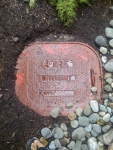While I prefer the work of a Truck Co, there is no better sound to hear when doing an aggressive primary search, than the sound of flowing water. Hearing the Engine Co pushing in with the line is pure magic. As much as I would like to say that we truckie’s can stomp out the flames ourselves, one good job makes you appreciate the little fellas, human door chocks, ah…the engine!
While on vacation, chasing my kids through this nicely landscaped garden, I noted something red. What was hidden here?
- Where’s the hydrant Waldo?
- Have you pre-planned, Are you ready?
Obviously this is something that all first alarm responding engine company chauffeur’s and officers need to be aware of. This should occur in multiple layers, in pre-planning, be announced over the air in a “Critical Dispatch Information”, and again while on the fireground. You can only imagine a relocated/fill in/transfer company responding in and attempting to find this hydrant, the delay could prove difficult and/or deadly.
Pre-planning and communicating water supply difficulties and “odd ball” water supply issues are paramount. Knowing your districts buildings and your nearest source of water will result in getting that all important positive water supply faster. Mastering these will create a safer work environment for our members and the citizens we protect.
Filed under: Engine Company |




I’m actually surprised that the mulch and stones don’t have it totally covered!!!
Below grade, or flush, hydrants are becoming more and more common. Originally their use in the states was in high continual traffic areas where an above grade barrel would be a constant obstruction. Rural and suburban areas use them as part of the dry hydrant (draft) system, with the barrel below grade being more visually appealing to today’s misguided citizens and where code allows. Hotels and various amusement attractions will employ them as well, and in the case of hotels, they may be tied into the pool as a type of dry hydrant system. The pool connection seems to be the most widely used, especially in the rural areas.
Most are designed with one 2-1/2″ and one 4-1/2″ outlet. I’ve seen other manufactures make them with only a one 4-1/2″ Stortz connection.
On the west coast, some manfacturers and installers are promoting below grade hydrants to municipalities as a means to combat vandalism.
Good site, by the way.
Bill,
Thanks for the compliments and the good information.
-Nick